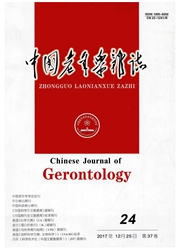

 中文摘要:
中文摘要:
目的 观察益气活血法对脑出血大鼠脑内损伤区血管新生和凝血酶敏感蛋白-1(TSP-1)、凝血酶敏感蛋白-2(TSP-2)及其受体CD36表达的影响.方法 胶原酶诱导建立大鼠脑出血模型,随机分为正常组、假手术组、模型组、益气组、活血组、益气活血组,不同时间点灌注取脑,采用脑微血管银染法观察血管新生情况、免疫组化法观察各指标的表达情况.结果 银染法益气活血组14~28 d血肿周围及内部新生血管较其他各组多,35 d可见血肿完全吸收,其他各组仍有较小血肿.TSP-1与TSP-2分别在造模后4、28 d达高峰,CD36在造模后4、28 d呈双峰表达.益气活血组4 d TSP-1的表达高于模型组(P<0.01),4~7 d下降明显,21 d TSP-2的表达低于模型组(P<0.05),28 d表达高于模型组(P<0.05).结论 益气活血法可能通过调整脑出血大鼠脑内TSP-1、TSP-2及其受体CD36的表达,降低其对血管新生的抑制作用,加快血肿吸收,促进脑组织修复.
 英文摘要:
英文摘要:
Objective To investigate the effects of invigorating qi promoting blood flow therapy on expressions of thrombospondin (TSP)-1, TSP-2 and their receptor CD36 in brain of intracerebral hemorrhagic (ICH) rats and explore its mechanisms. Methods ICH model rats induced by injecting collagenase type Ⅶ were randomly divided into six groups and were perfused at different time to observe angiogenesis by argentation and to determine the expressions of TSP-1, TSP-2 and CD36 by immunohistochemistry. Results Argentation: the new vessels of surrounding and inside hematomas during 14 - 28 d in invigorating qi promoting blood flow therapy group were more than those in the other groups; and hematomas in invigorating qi promoting blood flow therapy group was absorbed completely at 35 d, yet that in the other groups was small. Immunohistochemistry: TSP-1, TSP-2 and CD36 peaked at 4, 28 d respectively. The expressions of TSP-1 were higher at the 4th day (P 〈0.01 ), that of TSP-2 were lower at the 21st day (P 〈0.05) and were higher at the 28th day (P 〈0.05) in invigorating qi promoting blood flow therapy group than those in control group. Conclusions Invigorating qi promoting blood flow therapy could regulate the expressions of TSP-1, TSP-2 and their receptor CD36 in ICH rat's brains to lower the depressant effects on angiogenesis, accelerate the absorption of hematomas and promote cerebral tissue repair.
 同期刊论文项目
同期刊论文项目
 同项目期刊论文
同项目期刊论文
 期刊信息
期刊信息
